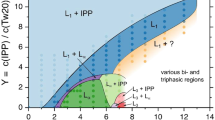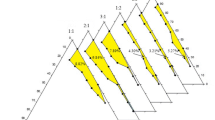Abstract
The unique properties of jojoba oil make it an essential raw material in the manufacture of cosmetics. New, totally dilutable U-type microemulsions of water, jojoba oil, alcohols, and the nonionic surfactant polyoxyethylene-10EO-oleyl alcohol (Brij 96V) have been formulated recently. Here, these microemulsions are shown to be capable of solubilizing lycopene, a nutraceutical insoluble in water and/or oil, much more effectively than the solvent (or a solvent and surfactant blend) can dissolve them. In water-in-oil (W/O) and oil-in-water (O/W) microemulsions with 10 and 90 wt% water, respectively, the normalized maximal solubilization efficiency α is ca. 20-fold larger than its solubility. The solubilization capacity of the system is mainly surfactant-concentration dependent. The lycopene resides at the interfaces of the W/O and O/W microemulsions and engenders significant structural changes in the organization of the microemulsion droplets. In the absence of lycopene, the droplets are spherical; when lycopene is added, compaction of the droplets and formation of threadlike droplets are observed. On further addition of lycopene, the bridging effect wanes and the droplets revert to a spherical shape. The enhanced solubilization demonstrated for lycopene opens up new options for formulators interested in making liquid and transparent products for cosmetic or pharmaceutical uses.
Similar content being viewed by others
References
Shani, A., The Struggles of Jojoba, CHEMTECH 25(5):49–54 (1995).
Schwarz, J.S., M.R. Weisspapir, A. Shani, and S. Amselem, Enhanced Anti-inflammatory Activity of Diclofenac in Jojoba Oil Submicron Emulsion Cream, J. Appl. Cosmetol. 14:19–24 (1996).
El-Laithy, H.M., and K.M.F. El-Shaboury, The Development of Cutina Lipogels and Gel Microemulsion for Topical Administration of Fluconazole, AAPS Pharm. Sci. Tech. 3(4):35 (2003).
Malmsten, M., Surfactants and Polymers in Drug Delivery, Marcel Dekker, New York, 2002, pp. 133–159.
Holmberg, K., Quarter Century Progress and New Horizons in Microemulsions, in Micelles, Microemulsions, and Monolayers, edited by D.O. Shah, Marcel Dekker, New York, 1998, pp. 161–192.
Rao, A.V., and S. Agarwal, Role of Lycopene as Antioxidant Carotenoid in the Prevention of Chronic Diseases: A Review, Nutr. Res. 19:305–323 (1999).
Bramley, P.M., Is Lycopene Beneficial to Human Health? Phytochemistry 54:233–236 (2000).
Regev, O., S. Ezrahi, A. Aserin, N. Garti, E. Wachtel, E.W. Kaler, A. Khan, and Y. Talmon, A Study of the Microstructure of a Four-Component Nonionic Microemulsion by Cryo-TEM, NMR, SAXS, and SANS, Langmuir 12:668–674 (1996).
Spernath, A., A. Yagmur, A. Aserin, R.E. Hoffman, and N. Garti, Self-Diffusion Nuclear Magnetic Resonance, Microstructure Transitions, and Solubilization Capacity of Phytosterols and Cholesterol in Winsor IV Food-Grade Microemulsions, J. Agric. Food Chem. 51:2359–2364 (2003).
Amar, I., A. Aserin, and N. Garti, Solubilization Patterns of Lutein and Lutein Esters in Food Grade Nonionic Microemulsions, 51:4775–4781 (2003).
Spernath, A., A. Yagmur, A. Aserin, R. Hoffman, and N. Garti, Food-Grade Microemulsions Based on Nonionic Emulsifiers: Media to Enhance Lycopene Solubilization, 51:6917–6922 (2002).
von Corswant, C., and P.E.G. Thoren, Solubilization of Sparingly Soluble Active Compounds in Lecithin-Based Microemulsions: Influence on Phase Behavior and Microstructure, Langmuir 15:3710–3717 (1999).
Author information
Authors and Affiliations
Corresponding authors
About this article
Cite this article
Garti, N., Shevachman, M. & Shani, A. Solubilization of lycopene in jojoba oil microemulsion. J Amer Oil Chem Soc 81, 873–877 (2004). https://doi.org/10.1007/s11746-004-0994-4
Received:
Accepted:
Issue Date:
DOI: https://doi.org/10.1007/s11746-004-0994-4




